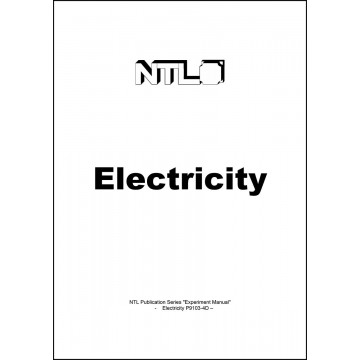


Measuring voltage – voltage sources
ELD 2.1 Measuring voltage
ELD 2.2 Terminal voltage – open-circuit voltage
ELD 2.3 Voltage drop across a switch
ELD 2.4 Voltage drop across a light bulb
ELD 2.5 Amperage is the same everywhere in a simple circuit
ELD 2.6 Amperage in circuits with branches
ELD 2.7 Voltage sources in series and parallel circuits – voltage measurement
ELD 2.8 Voltage sources in series and parallel circuits – amperage measurement
ELD 2.9 Voltage sources in series and parallel circuits – short-circuit current
Ohm’s law – resistor circuits
ELD 3.1 The greater the voltage, the greater the amperage: Ohm’s law
ELD 3.2 The shorter the wire, the greater the amperage
ELD 3.3 The thicker the resistance wire, the smaller the resistance
ELD 3.4 Resistance depends on what the resistance wire is made of
ELD 3.5 Iron wire is a PTC conductor
ELD 3.6 A light bulb is a PTC conductor
ELD 3.7 Ohm’s law demonstrated using fixed resistors
ELD 3.8 Resistors in series circuits 1
ELD 3.9 Resistors in series circuits 2
ELD 3.10 Resistors in parallel circuits 1
ELD 3.11 Resistors in parallel circuits 2
ELD 3.12 Resistors in parallel circuits 3
ELD 3.13 Voltage drop
ELD 3.14 Model of a potentiometer
ELD 3.15 Voltage drop and light bulbs
ELD 3.16 Potentiometer and a light bulb used as an indicator
ELD 3.17 Model of a fader
Electrical appliances – safety devices
ELD 4.1 Work and power of electrical current
ELD 4.2 Electrical devices are wired parallel and not in series in a circuit
ELD 4.3 Resistance wire converts electrical energy to thermal energy
ELD 4.4 Model of an immersion heater
ELD 4.5 Fires caused by electricity
ELD 4.6 Short circuits are a fire hazard
ELD 4.7 Fuses prevent fire hazards
ELD 4.8 Bridging fuses is dangerous!
ELD 4.9 The incandescent effect of a filament
ELD 4.10 Overloading causes fire hazards – fuses prevent hazards
ELD 4.11 Model of a hot-wire instrument
ELD 4.12 Model of a thermostat
ELD 4.13 Bimetallic strip as circuit-breaker
Thermocouple element – electrochemistry
ELD 5.1 Principle of a thermocouple element
ELD 5.2 Thermocouple element
ELD 5.3 Principle of galvanic voltage
ELD 5.4 Measuring voltage using an oscilloscope
ELD 5.5 Voltage from ammonia and a salt solution
ELD 5.6 The Leclanche cell (flashlight battery)
ELD 5.7 Lead storage cell
ELD 5.8 NiFe storage cell
ELD 5.9 Electrolysis of a zinc-iodine solution
ELD 5.10 Electrolysis of a copper-chloride solution
ELD 5.11 Electrolysis of a table salt solution
ELD 5.12 Copper-plating zinc
ELD 5.13 An electrolytic rectifier
Electromagnetism
ELD 6.1 Oersted’s experiment
ELD 6.2 Force on a current-carrying conductor in a magnetic field 1
ELD 6.3 Force on a current-carrying conductor in a magnetic field 2
ELD 6.4 A coil’s magnetic field
ELD 6.5 Strength of a coil’s magnetic field
ELD 6.6 An iron core reinforces a current-carrying coil’s magnetic field
ELD 6.7 Model of a hoisting magnet
ELD 6.8 Ferromagnetic materials can be magnetized
ELD 6.9 Model of a moving iron instrument
ELD 6.10 Opening and closing an electrical circuit with the aid of a bar magnet
ELD 6.11 Model of a relay with break contact
ELD 6.12 Model of a relay with make contact
ELD 6.13 Model of a relay with break and make contact
ELD 6.14 Relay with make contact
ELD 6.15 Relay with break contact
ELD 6.16 Relay as a double-throw switch
ELD 6.17 Wagner’s hammer
ELD 6.18 Buzzer
ELD 6.19 Electric bell
ELD 6.20 Model of a magnetic fuse
Electromagnetic induction
ELD 7.1 A microphone converts sound into alternating current
ELD 7.2 Representation of audio frequency alternating current
ELD 7.3 How induced voltage is generated
ELD 7.4 Dependence of induced current on the magnetic field
ELD 7.5 Dependence of induced current on the number of turns of a coil
ELD 7.6 Making induced voltage visible
ELD 7.7 Self-induction in a coil
ELD 7.8 Model of a dynamo
ELD 7.9 Measuring short-circuit current
ELD 7.10 Power of induced current – an estimate
Transformers
ELD 8.1 DC transformer with windings on one axis
ELD 8.2 DC transformer with windings on parallel axes
ELD 8.3 DC transformer with iron core – one variety
ELD 8.4 DC transformer with iron core – another variety
ELD 8.5 Transformer used with a frequency generator 1
ELD 8.6 Transformer used with a frequency generator 2
ELD 8.7 Transformer used with a frequency generator and oscilloscope
ELD 8.8 AC-powered transformer used with a frequency generator and oscilloscope
ELD 8.9 AC-powered transformer (50 Hz)
ELD 8.10 Voltage transformation in a non-loaded transformer
ELD 8.11 Secondary voltage and coil position
ELD 8.12 Voltage transformation in a loaded transformer 1
ELD 8.13 Voltage transformation in a loaded transformer 2
ELD 8.14 Primary amperage in a non-loaded and loaded transformer 1
ELD 8.15 Primary amperage in a non-loaded and loaded transformer 2
ELD 8.16 Primary amperage in a non-loaded and loaded transformer 3
Generators
ELD 9.1 Electromagnetic induction – basic experiment
ELD 9.2 Electromagnetic induction – dynamo
ELD 9.3 Rotating conductor loop
ELD 9.4 AC generator
ELD 9.5 DC generator
ELD 9.6 AC generator with an electromagnet stator
ELD 9.7 DC generator with an electromagnet stator
ELD 9.8 Self-exciting DC generator
ELD 9.9 Self-exciting AC generator
Motors
ELD 10.1 The magnetic field of a rotating magnet
ELD 10.2 The magnetic field of a two-pole rotor with slip rings
ELD 10.3 The magnetic field of a two-pole rotor with a commutator
ELD 10.4 Two-pole rotor in a magnetic field
ELD 10.5 DC motor with a permanent magnet stator field
ELD 10.6 DC motor with an electromagnet stator field
ELD 10.7 Shunt-wound electric motor
ELD 10.8 Shunt-wound motor – current consumption under load
ELD 10.9 Series-wound motor
ELD 10.10 Synchronous motor
ELD 10.11 DC motor without a commutator